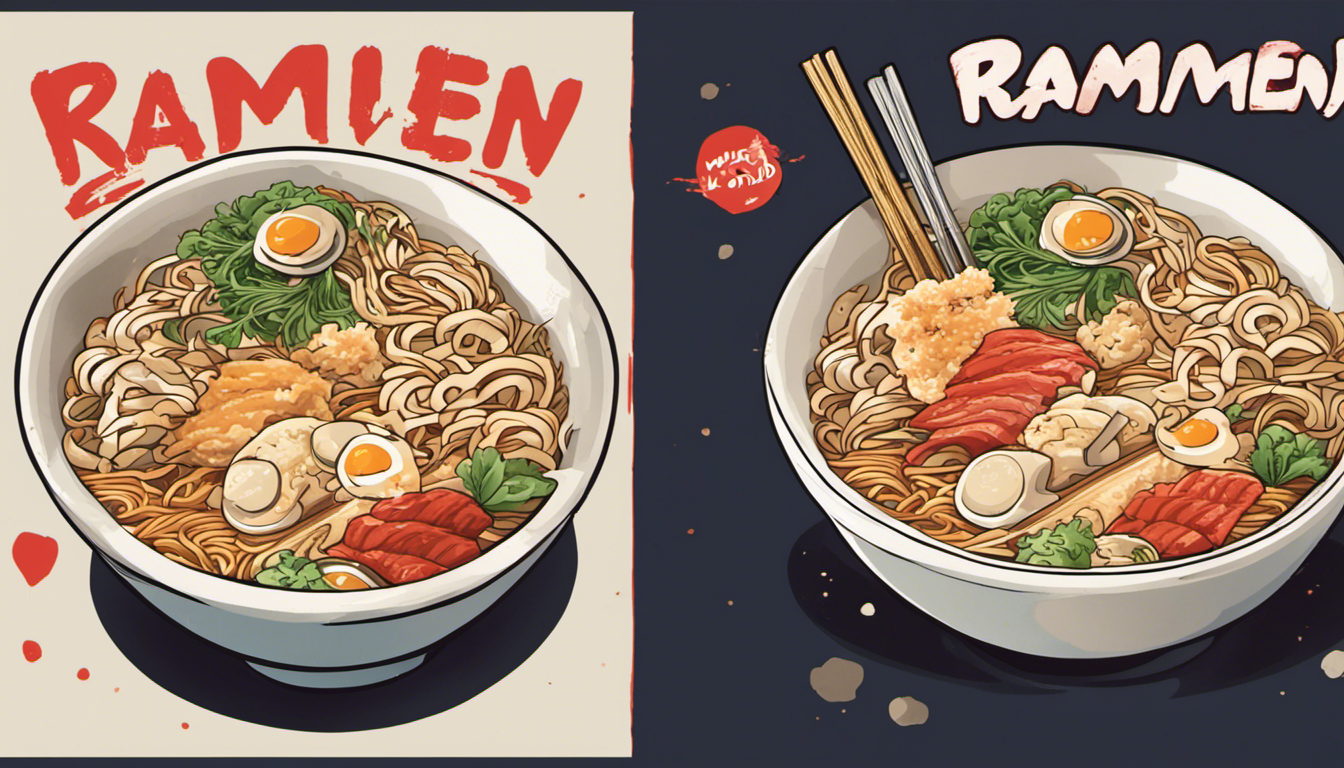ラーメン大好き!英語でラーメンワールドを楽しもう
ラーメン大好きなあなたに朗報です!英語でラーメンワールドを楽しむ方法をご紹介します。英語でラーメンを話題にすることで、日本の美味しい料理の魅力を世界に広めることができるだけでなく、英会話力もアップします。
本記事では、英語でのラーメン屋の表現や、醤油、味噌、塩などさまざまなラーメンのフレーズを学びます。また、ラーメン体験を外国人と共有する方法や、英語で”use noodle for ラーメン”と言っても通じるのか、”つけ麺”の英訳も解説。さらに、ラーメンのスープやトッピングの英語表現や、ラーメン店での注文の仕方、英会話の練習や、英語のレストランおすすめの聞き方なども詳しく説明します。
記事を読んで、以下のような内容をしっかり理解しましょう。
– 英語でのラーメン屋の表現方法
– 異なるラーメンのフレーズ
– ラーメンのスープやトッピングの英語表現
– 英語での注文の仕方
– ラーメンに関する英会話の練習
ラーメン大好きなあなたや、英語を学びたい方にとって、この記事は必読です。ラーメンを通じて、英語力を向上させましょう!

Exploring the World of Ramen in English
Ramen is a popular Japanese dish loved by people all over the world. It consists of Chinese-style wheat noodles served in a meat or fish-based broth, often flavored with soy sauce or miso, and uses toppings such as sliced pork, dried seaweed, and green onions. With its various flavors and unique preparation methods, ramen has become a global sensation. In order to properly share and discuss ramen with English speakers, it’s essential to know the correct vocabulary and expressions. Here, we will explore the world of ramen in English, from describing the dish itself to talking about different types of ramen and even the cultural aspects surrounding this delicious meal.
How to Say “ラーメン屋” (Ramen Shop) in English
In Japan, a “ラーメン屋” is a specialized restaurant that serves ramen. To convey this concept in English, you can simply use the term “ramen shop” or “ramen restaurant.” These establishments vary in size and style, but they all focus on providing customers with an authentic and satisfying ramen experience. When talking to foreigners or visiting an English-speaking country, you can use these phrases to recommend your favorite ramen shops or ask for their recommendations. You might even find some ramen dishes that are unique to that country!
Learn the English Phrases for Different Ramen Flavors
Ramen comes in a variety of flavors, and it’s essential to learn the English phrases for these different types. Here are some common flavors and their English translations:
– Shoyu: Soy Sauce Ramen
– Miso: Miso Ramen
– Shio: Salt Ramen
– Tonkotsu: Pork Bone Ramen
Knowing these terms makes it easier to talk about ramen with English speakers and helps ensure that you get the exact ramen flavor you want when dining out. It is also a fun way to engage in conversation and bond with people who share your love for ramen.

Sharing Your Ramen Experience with Foreigners
Sharing your ramen experience with foreigners can be a fun and educational way to connect with others. It’s essential to know how to describe the dish in English, as well as the different types of broth, noodles, and toppings that are used. You might also want to explain how to eat ramen properly, such as using chopsticks to pick up noodles and slurping them to cool them down while savoring the flavor. Don’t forget to mention the different regional variations of ramen in Japan and how they reflect the unique tastes and ingredients of each area. Additionally, share fun ramen-related stories, like your favorite ramen shop experiences or unique ramen dishes you’ve tried. Your passion for ramen will surely be infectious and may spark a newfound love for this Japanese culinary delight in those you speak with.
Can you use “noodle” for “ラーメン” in English?
In English, the word “noodle” refers to a broader category of pasta, which includes many different types, such as spaghetti, udon, and soba. While ramen is indeed a type of noodle, using the term “noodle” alone might be too vague and could lead to confusion when talking about ramen specifically. To avoid any misunderstandings, it’s best to use the term “ramen” when referring to this particular type of noodle dish in English, especially because the word is widely recognized and understood by most English speakers.
The English translation of “つけ麺”
つけ麺 is a popular Japanese dish, often referred to as “tsukemen” in English. This dish consists of noodles served separately from a flavorful dipping sauce or broth. The key to fully enjoying tsukemen lies in the perfect balance of the noodles’ texture and the rich, savory broth. When ordering tsukemen at a ramen shop, you might even customize your order by choosing the thickness of your noodles or the level of spiciness in the broth.
Improve Your English by Talking About Ramen
Talking about your favorite ramen dishes can be a fun and engaging way to improve your English skills. The diverse world of ramen offers various topics to discuss, such as types of noodles, soup bases, and toppings. Sharing your experiences visiting ramen shops, describing the delicious flavors you’ve tasted, and even recommending local spots to fellow ramen enthusiasts can provide ample opportunities to practice your vocabulary and expand your knowledge of the culinary art that is ramen.

How to Describe Ramen Soups and Toppings in English
Describing ramen soups and toppings is an essential skill for any ramen lover. Begin by identifying the soup base, which can range from shoyu (soy sauce), miso, tonkotsu (pork bone), to shio (salt). Next, describe the texture and flavor of the noodles, such as thick, thin, chewy, or firm. Finally, list and describe the various toppings that complete the dish. Common ramen toppings include soft-boiled eggs, chashu (sliced pork), nori (seaweed), menma (bamboo shoots), green onions, and even unconventional ingredients like cheese or corn. When discussing these elements in English, use descriptive adjectives and clear phrasing to paint a vivid picture of your favorite ramen bowl.
Useful Phrases for Ordering Ramen at a Restaurant
When ordering ramen at a restaurant, it’s crucial to know some essential phrases to communicate your preferences effectively. Firstly, specify the type of ramen you’d like, such as “I’d like the tonkotsu ramen, please.” You can also customize your order by stating preferences like “Can I have extra chashu?” or “Could you make it less spicy?” If you have dietary restrictions or allergies, inform the staff with phrases like “I’m allergic to peanuts” or “Do you have a vegetarian option?” By mastering these useful phrases, you can confidently navigate any ramen menu and enjoy a satisfying meal.
Practicing英会話 with a Ramen-relatedTOEICListening Question
Enhance your 英会話 skills by tackling a ramen-related TOEIC listening question. Listen carefully to the conversation and pay attention to keywords associated with ramen, such as soup base, toppings, and noodle types. Answer the accompanying question based on the information provided in the audio clip. Practicing with ramen-themed listening activities not only improves your listening comprehension but also familiarizes you with the vocabulary needed for discussing ramen in English.
Knowing how to ask for restaurant recommendations in English
Asking for restaurant recommendations, especially when it comes to ramen, is a valuable skill when traveling or interacting with English speakers. By asking for suggestions, you can discover the most popular ramen shops and taste the best Japanese cuisine. To effectively inquire about ramen restaurants, it’s important to have a good grasp of key English expressions and vocabulary. For instance, you may ask, “What’s the best ramen shop in town?” or “Can you recommend a good place for Japanese noodles?”
Utilizing a reliable site or app can enhance your learning process. They offer an extensive list of useful phrases, explanations, and even interactive quizzes to test your knowledge. Aim to take advantage of these resources to strengthen your English speaking skills and confidence in asking for restaurant recommendations.
Remember, practice makes perfect. Engage in conversations with native English speakers or participate in online forums to hone your language abilities. By regularly engaging in discussions, you’ll soon be able to effortlessly ask for ramen restaurant recommendations and enjoy the delightful flavors of Japanese cuisine.

Interactive Learning – Ramen English Quiz
Mastering the vocabulary related to ramen and its ingredients is essential for accurately describing and understanding this Japanese dish. To efficiently learn these terms, consider participating in an interactive learning experience with a Ramen English Quiz. This enjoyable and engaging method helps deepen your knowledge of English words and meanings, while also familiarizing you with various ramen types, such as Shoyu, Miso, and Shio.
Challenge yourself by taking quizzes that test your comprehension of ramen-related vocabulary and phrases. Many online platforms offer quizzes with varying difficulty levels, allowing users to progressively improve their skills. As you advance, you can also practice forming sentences using the newly acquired terms. Additionally, quizzes can serve as a benchmark for measuring your progress and identifying areas that require further study.
By actively engaging with Ramen English Quiz resources, not only will your English proficiency improve, but your knowledge of Japanese cuisine will expand as well.
Test Your Knowledge on Ramen Vocabulary
Improving your understanding of ramen-specific vocabulary is crucial for effectively describing this Japanese dish to others. Start by learning essential terms, such as the various types of ramen – Shoyu (soy sauce), Miso (soybean paste), and Shio (salt). Familiarize yourself with common ramen ingredients, like Chashu (braised pork), Menma (bamboo shoots), and Ajitama (soft-boiled egg).
Once you’ve become comfortable with these expressions, practice using them in sentences and scenarios. For example, “I love the rich flavors of the Miso ramen with Chashu and Menma at the local shop.” Participate in online discussions or ask questions on forums to further refine your language abilities. Quiz yourself regularly to ensure you retain the vocabulary and improve over time.
By actively testing your knowledge on ramen vocabulary, you’ll be well-equipped to describe this beloved Japanese dish to others in English with ease.
Can you describe a bowl of ramen accurately?
To accurately describe a bowl of ramen, it’s essential to know the relevant terminology and understand the components that make up the dish. Start by identifying the broth’s base – Shoyu, Miso, or Shio. Next, focus on the noodles, noting their texture and thickness. Finally, mention the toppings, such as Chashu, Menma, and Ajitama.
A well-crafted description might sound like this: “The Shoyu ramen has a rich, savory broth, thin, springy noodles, and is topped with succulent Chashu, crunchy Menma, and a perfectly cooked Ajitama.” Practicing your descriptive abilities not only expands your English vocabulary but also enhances your overall communication skills.
Continue honing your language skills for better ramen descriptions and impress your friends with your knowledge of this delicious Japanese dish.

Wrap Up: Enhance Your English Skills Through Ramen
Overall, delving into the world of ramen can significantly enhance your English language skills. From mastering vocabulary to understanding various types and ingredients, learning about ramen allows you to express yourself more eloquently in English. As you progress, remember to practice actively through quizzes, discussions, and real-life scenarios. By doing so, you’ll not only become proficient in English but also gain a deeper appreciation for Japanese cuisine.
Ready to put your newfound knowledge into action? Head to your favorite ramen restaurant and confidently order in English or strike up a conversation with fellow diners. Don’t forget to share your experiences and continue your language learning journey.
留学の相談やワーキングホリデーの相談を専門に受け付けている、プロの留学カウンセラーです。何かご質問があれば、ぜひメールでどうぞ!







